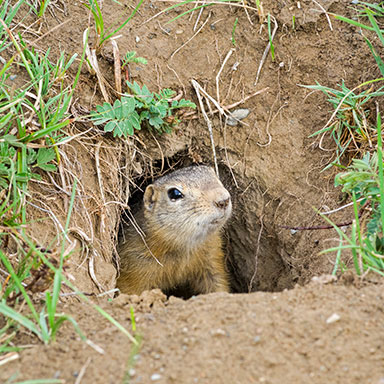Gophers are rodents that live underground in extensive tunnel systems that they dig. A single gopher can cause serious damage to a lawn or garden. Gophers can also carry diseases and parasites that can affect humans as well as pets and livestock. It is always best to have the gopher removed from your property as quickly as possible to eliminate any health issues that might occur through contact with the rodent and to minimize any damage to your lawn or garden. There are two common signs that a gopher has invaded your property.
Dirt Mounds
The first sign of a gopher in your lawn or garden is often the sudden appearance of a dirt mound. The mound is formed as the gopher discards excess soil above ground during construction of its tunnel. The mound may appear fan-shaped while the gopher is actively removing dirt, but it will often assume a round or oval shape once the gopher finishes excavation in that location and plugs the exit hole. The gopher will then continue excavating its many tunnels and chambers, depositing additional dirt mounds throughout the lawn.
The best time for a professional pest control technician to capture and remove the gopher is when it is actively removing dirt from its excavation. Gophers are cautious and will immediately retreat down their tunnels when confronted. The sudden appearance of danger will cause the gopher to flee and leave the exit hole open, allowing the pest control technician to easily set a mechanical trap. The gopher will soon return to plug the exit hole and will be captured by the trap. Inactive but fresh gopher mounds can also be used to trap gophers, but the technician will need to reopen the hole and dig until the tunnel is exposed. Mechanical traps are the safest and most humane way to remove a gopher.
Damaged Vegetation
Dirt mounds may not always be present or visible. A gopher may suddenly arrive from an adjacent property or from the other side of a privacy fence. Any sudden and unexplained damage to or loss of vegetation could signal an invasion from this opportunistic feeder. Gophers usually attack plants from within their tunnels and begin eating them from the roots up. Small plants can be pulled down into the tunnel and completely disappear. Gophers, or pocket gophers as they are normally called, have pockets within their mouths where they store food until they can deposit it into chambers within their vast tunnel systems. With large hoards of food available to them for later consumption when food may not be as readily abundant, gophers will quickly and voraciously attack vegetation in lawns and gardens.
Gophers can also forage above the ground. When they do, they will normally attack plants and trees just above the soil line. They may take a few bites out of the plant or girdle a small tree.
For Help Controlling Gophers and Other Pests
To determine if your lawn and garden plants are under attack from gophers, contact Valley Pest Solutions. We are a family owned company providing environmentally sound, effective treatments for all types of pests.

